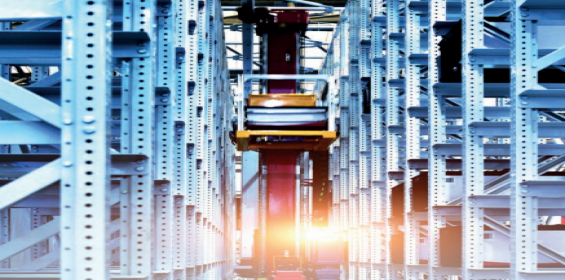Driving innovation on the warehouse floor
Published: 01 November, 2021
Wayne Turtill, product manager, Drives, Servos and LVS at Mitsubishi Electric, explains what to look for when selecting VSDs for futureproof stacker cranes.
To improve throughput and space utilisation, warehouses use stacker cranes for the automated retrieval and storage of goods. While operating at high speed, these devices effectively locate, pick, transport and unload cargo. Variable speeds drives (VSDs) play a key role in determining their correct and effective operations.
The first features that businesses should look for when specifying VSDs for stacker cranes is accuracy and repeatability. These are achieved by different types of control that work together to precisely position loading platforms, forks and trolleys.
Position awareness for effective, safe operations
Using a variable speed drive that allows users to create operation patterns based on key parameters, such as frequency as well as scurve acceleration and deceleration time, is a good starting point to deliver advanced position accuracy. Moreover, a drive that can support closed-loop and dual feedback control via encoders as well as laser sensors, can enhance both tracking and spatial accuracy. Stacker cranes with VSDs that incorporate these controls can shorten the time required to get to a defined location and avoid unnecessary adjustments to fine-tune their positioning.
Another key function that can help warehouses realise high-speed and accurate operations is anti-sway control, which minimises swinging once the stacker crane has reached its destination. In effect, since the device remains stable, loading and unloading can occur quickly while positional accuracy is improved.
By choosing a VSD that can interpret laser distance measurements, stacker cranes can also adapt to their environments and operational changes. For example, obstacles between the crane and the laser reflector can be detected, with an advanced VSD able to flag the anomaly and initiate an emergency stop. Additional sensor-based functionalities that can contribute to system safety include detection of crane overspeed, position deviation or close proximity to the reflector.
Mighty, small and smart
While delivering next-level performance is essential for VSDs in stacker crane applications, their overall footprint also needs to be kept to a minimum. Maximising storage space in warehouses is a must and therefore compact drives that can control multiple motors simultaneously are preferred. They can also help minimise capital expenditure while enhancing the overall synchronicity of the system.
A further aspect that needs to be considered when specifying VSDs is the ease of installation and use. Mitsubishi Electric’s FR-A800 AWH, for instance, was specifically developed to provide a turnkey system for automated warehouse applications.
The drive contains dedicated algorithms and programs for stacker cranes, so that end users simply need to insert the key variables and parameters that apply to their intended system. Based on this input, the VSD will then determine the best process automatically and adjust settings accordingly. For example, users can benefit from the VSD’s automatic creation of operation patterns without the need to spend time developing specific controller codes. As a result, businesses can streamline drive installation as well as modifications to support changes in the application. In effect, setup times can be cut from days to only a few hours.
In addition, the FR-A800 Plus supports secure remote monitoring via a free app for laptops and mobile devices, fast-tracking troubleshooting, and maintenance activities. Finally, the innovative drive was designed with a durable substrate coating and conductive plates to offer a rugged solution that prevents dust from entering its circuits. This maximises the VSD service life and resistance to warehouse environmental conditions.
A state-of-the-art VSD, such as the FRA800 Plus, can help warehouses benefit from accurate, repeatable, and easy-to-use stacker crane systems. These can address current and future challenges in the sector by offering advanced capabilities that contribute to the overall competitiveness of a business.
https://www.linkedin.com/company/mitsubishielectric/
https://www.facebook.com/MitsubishiElectric/







